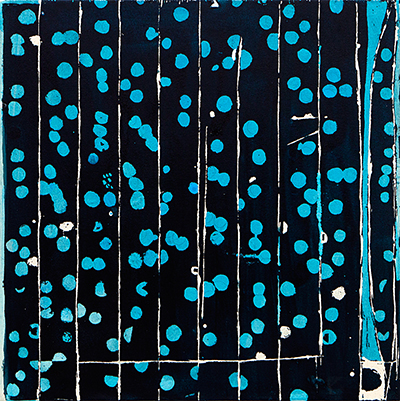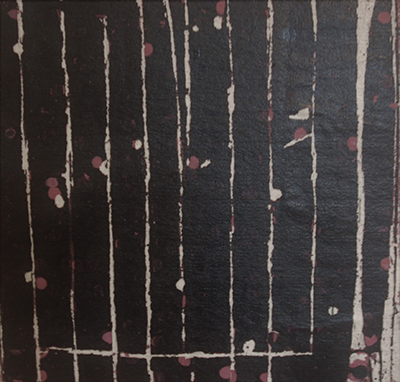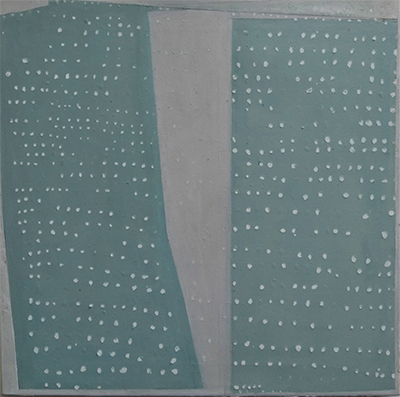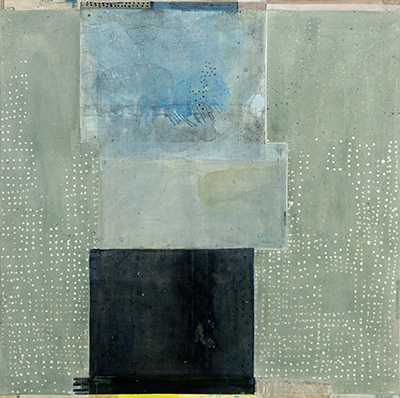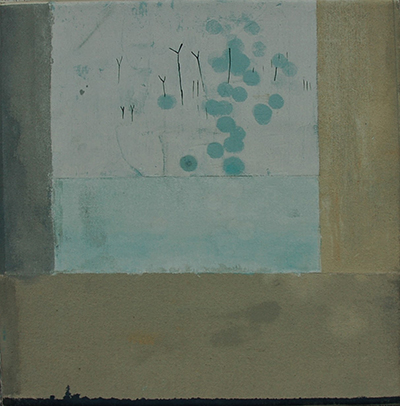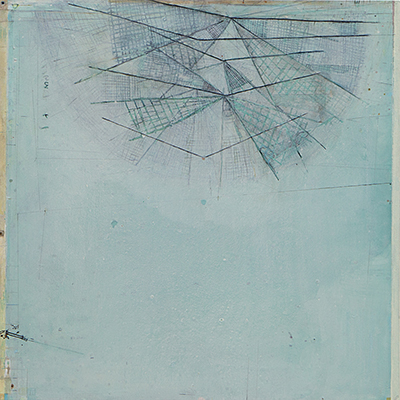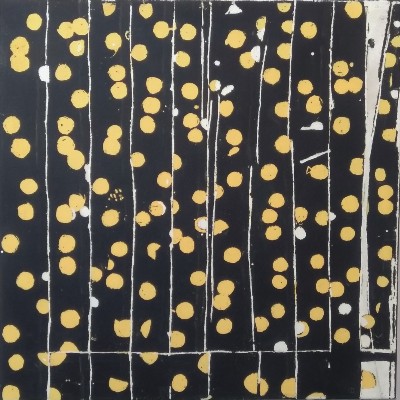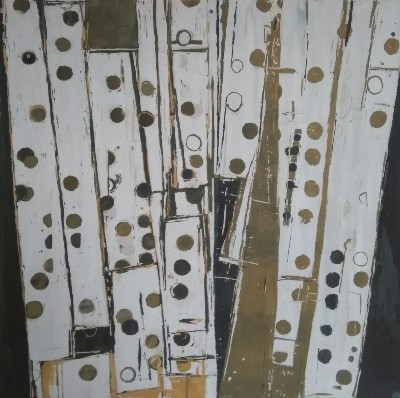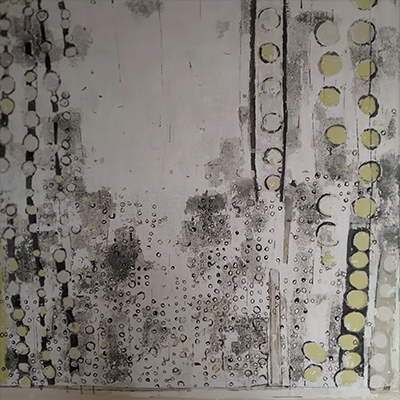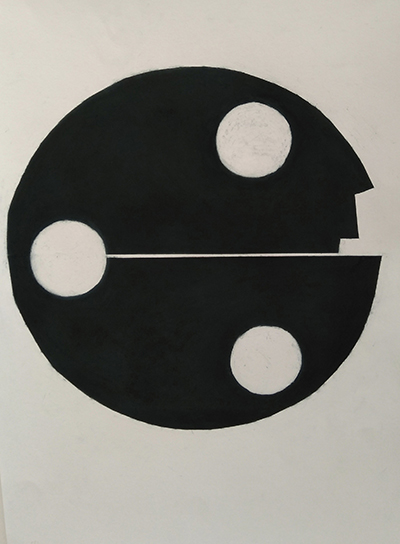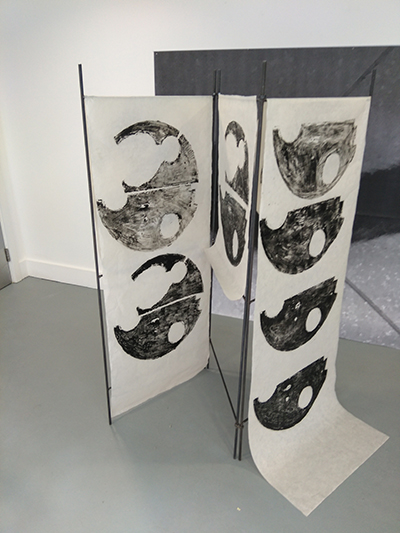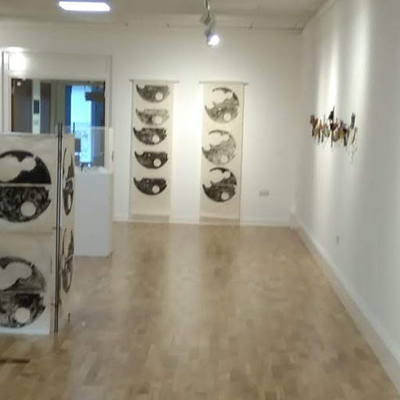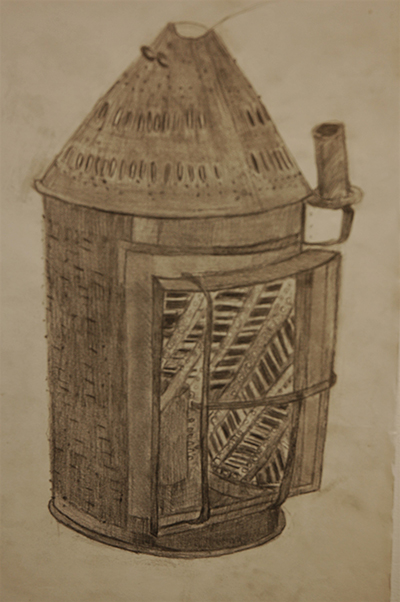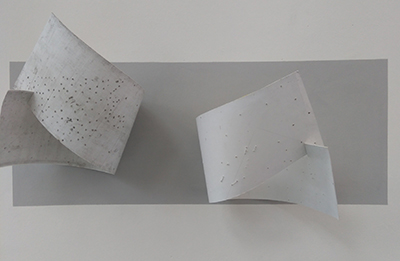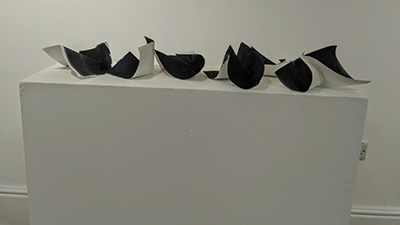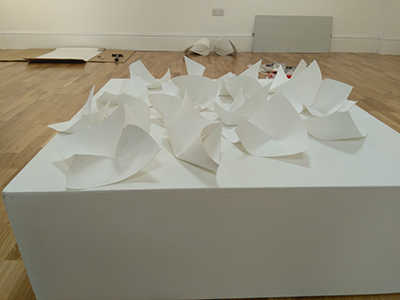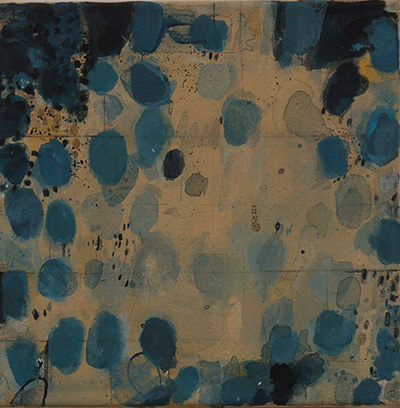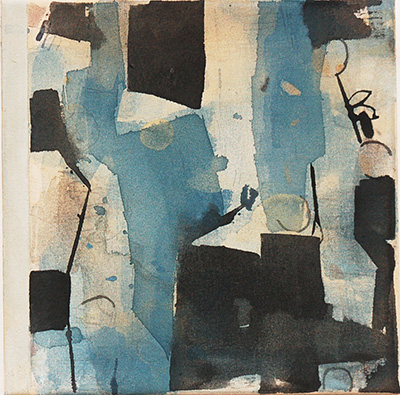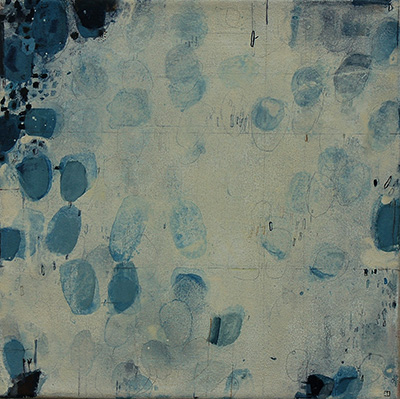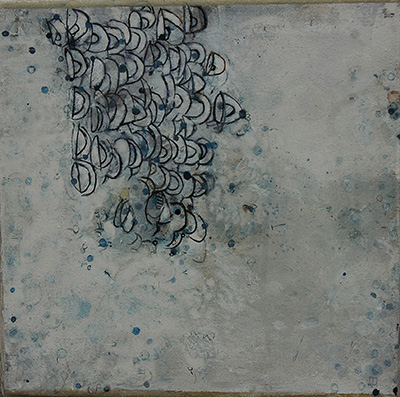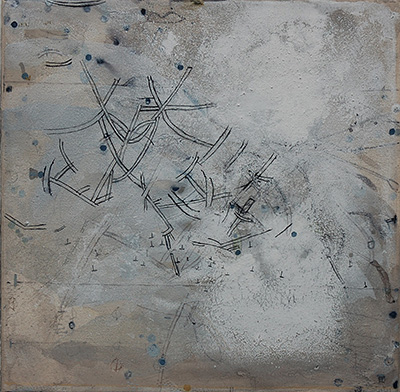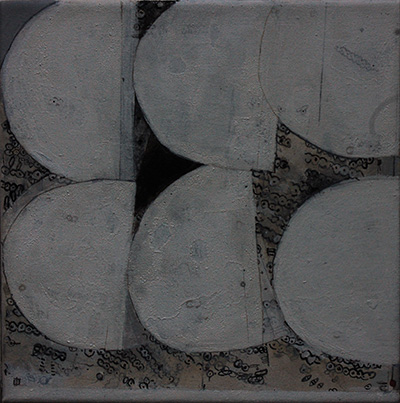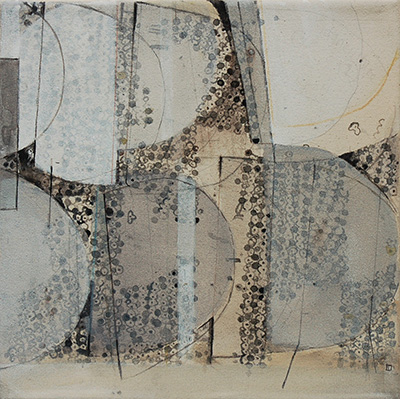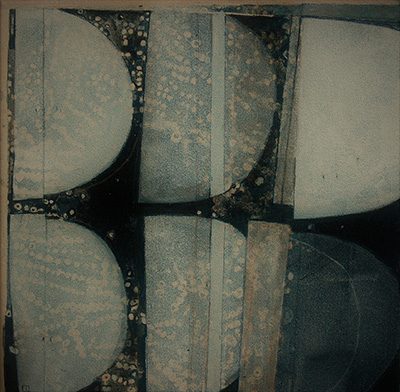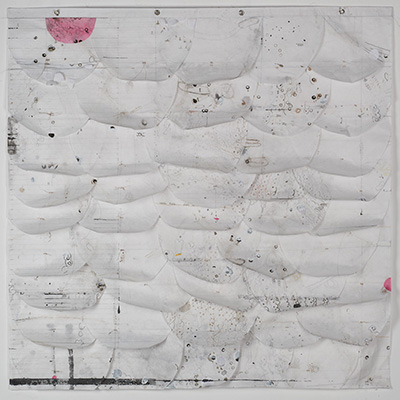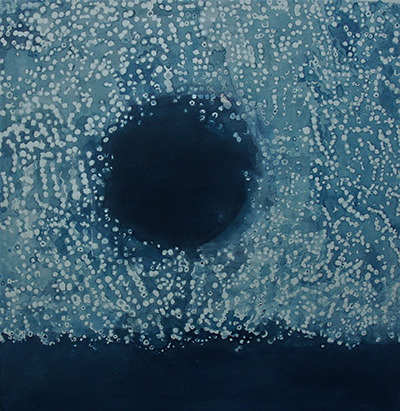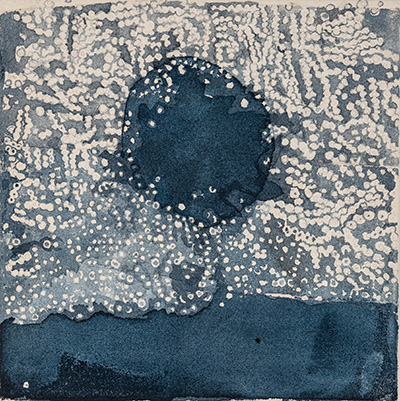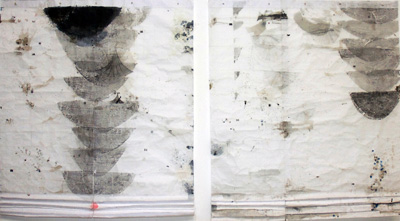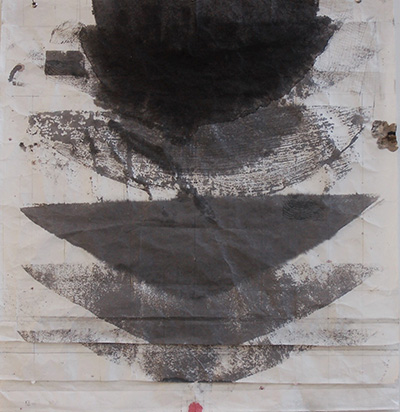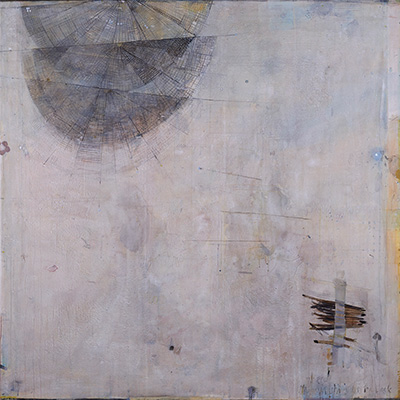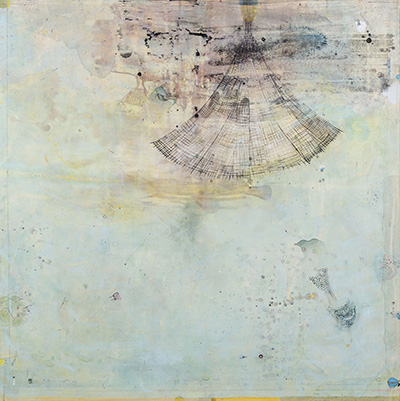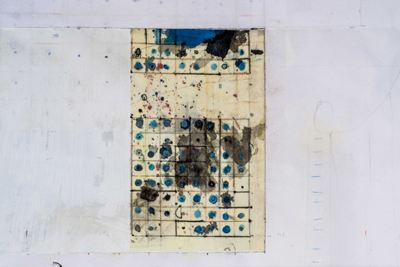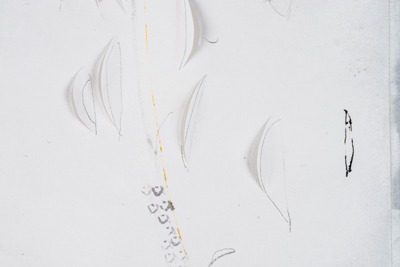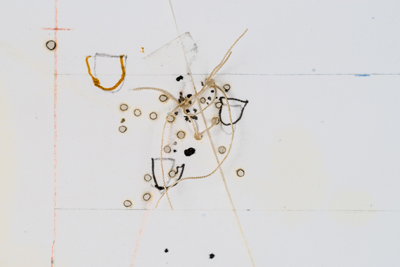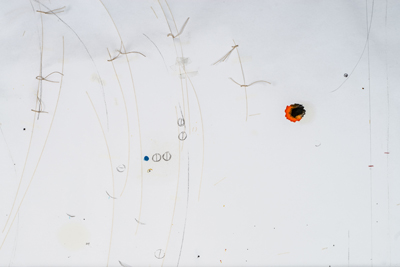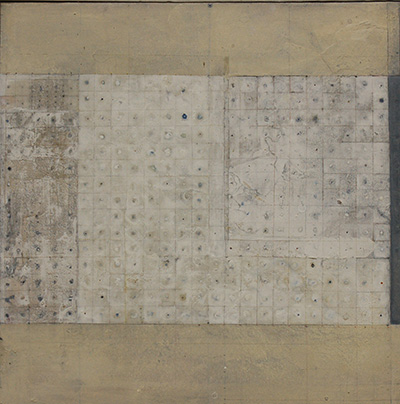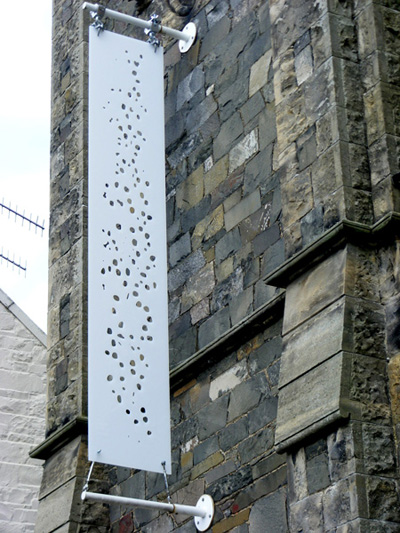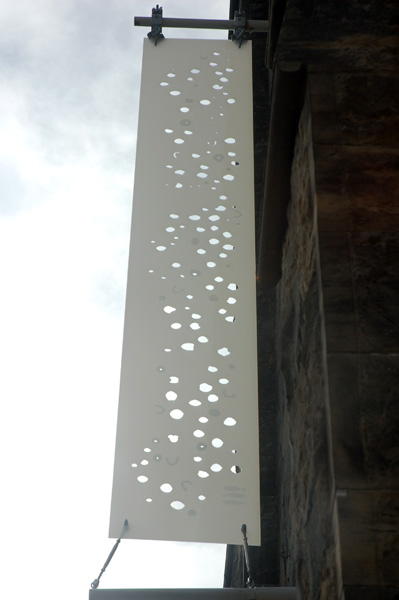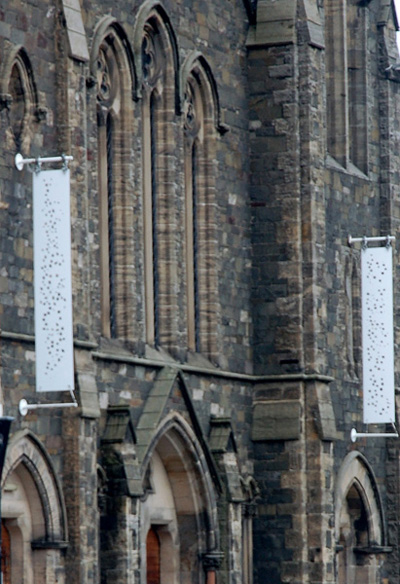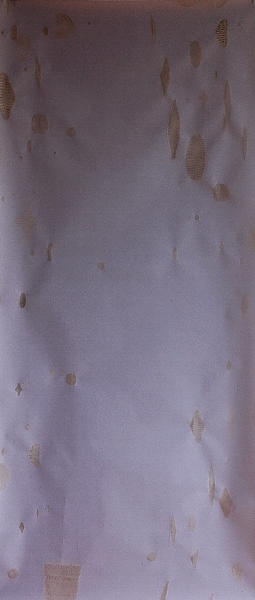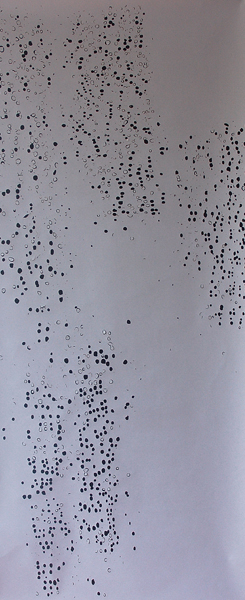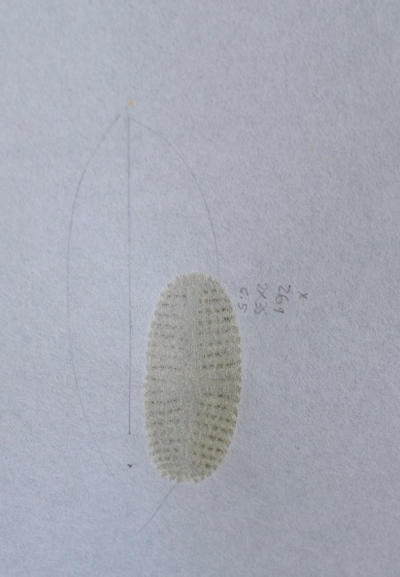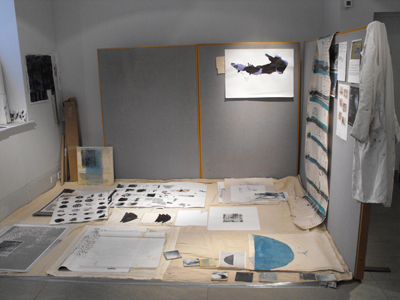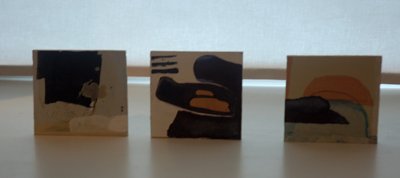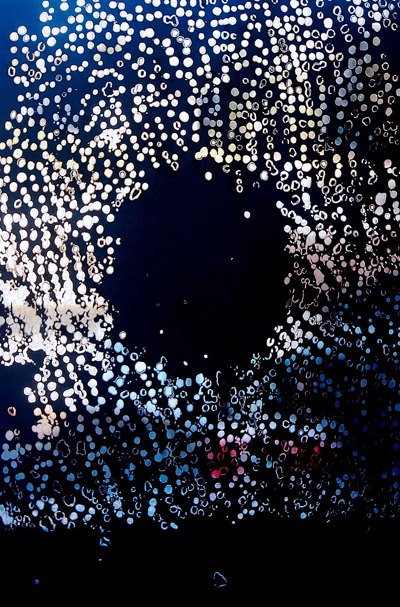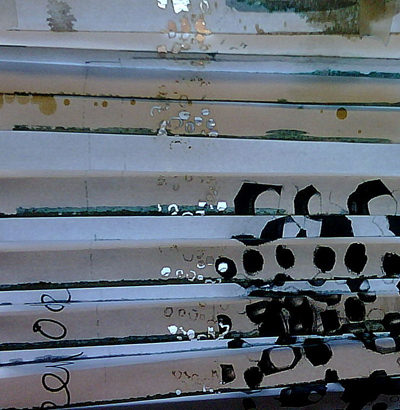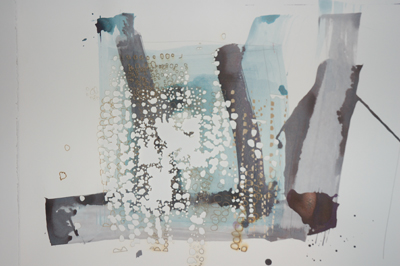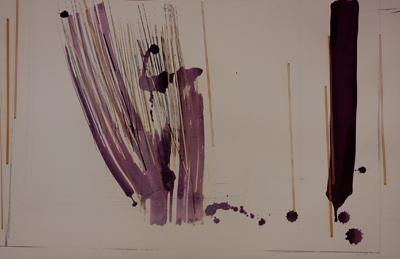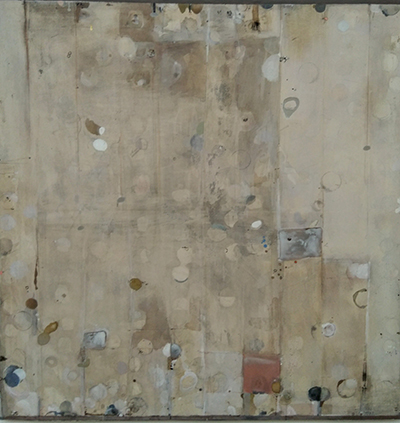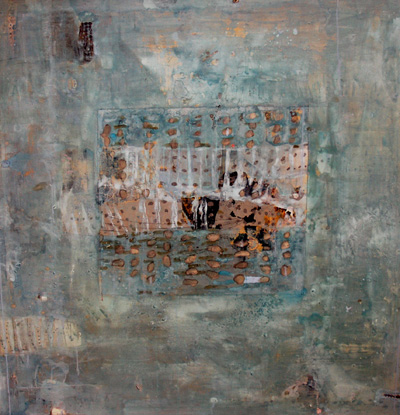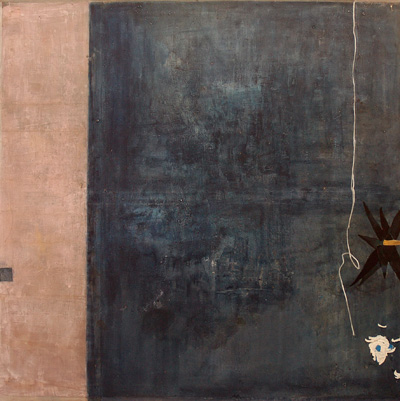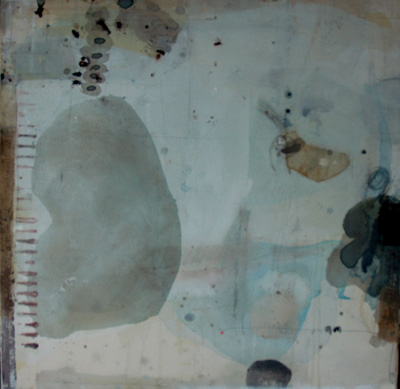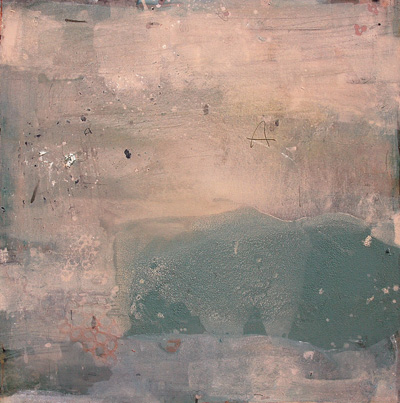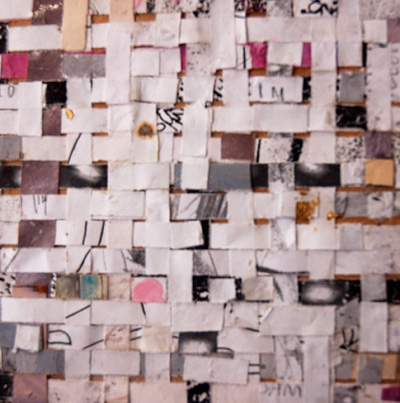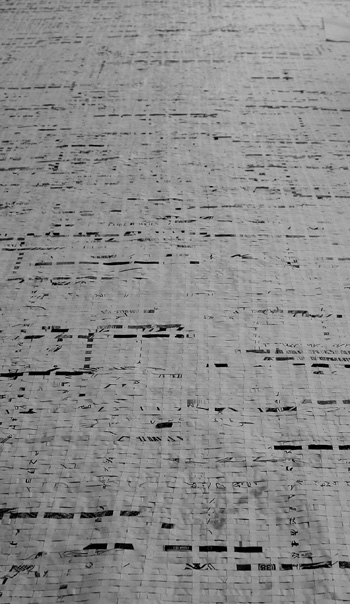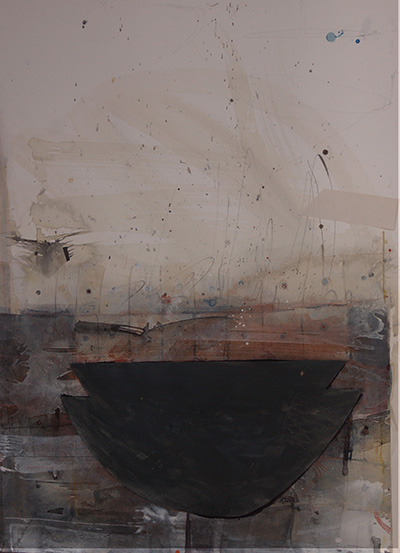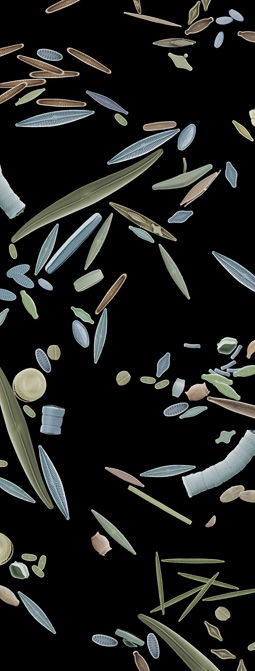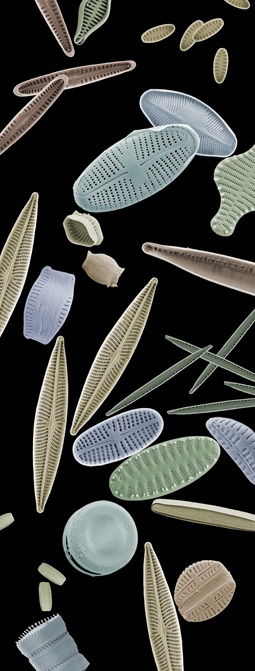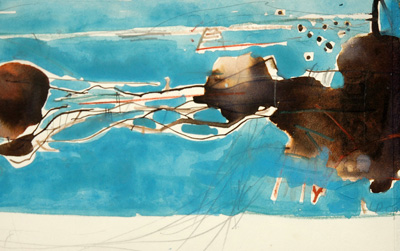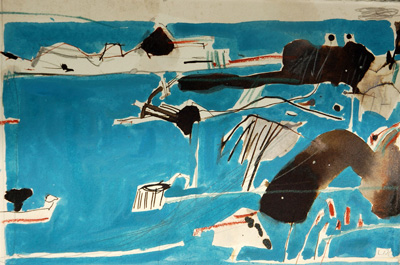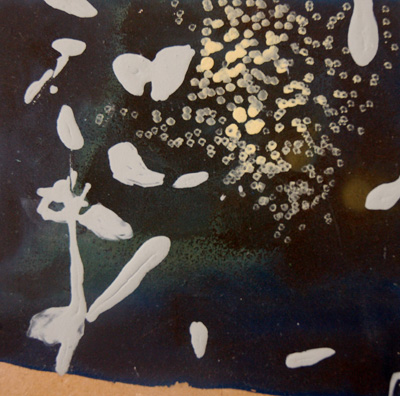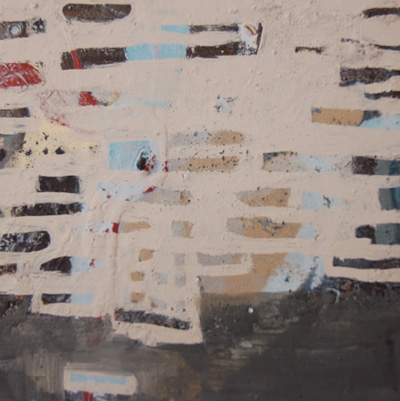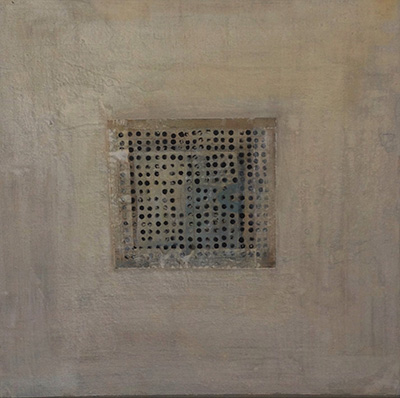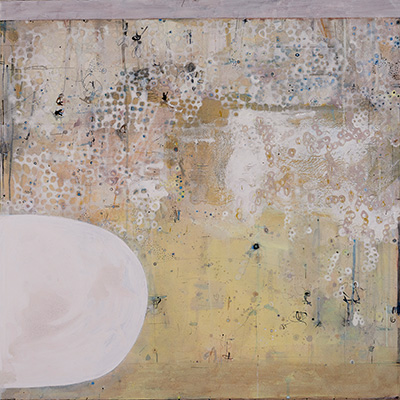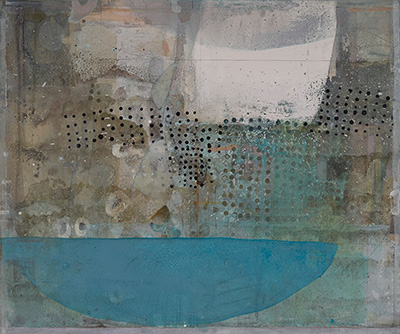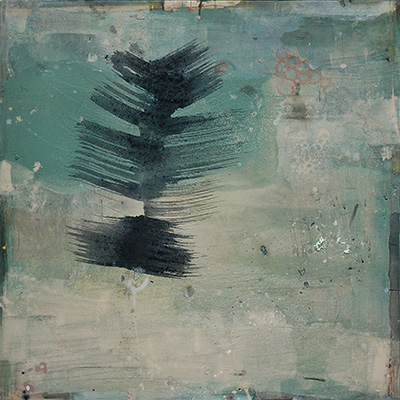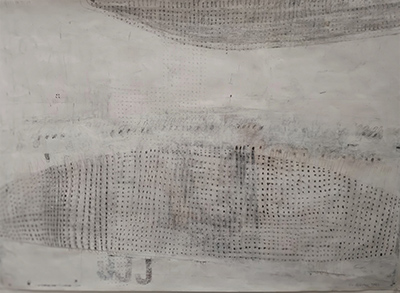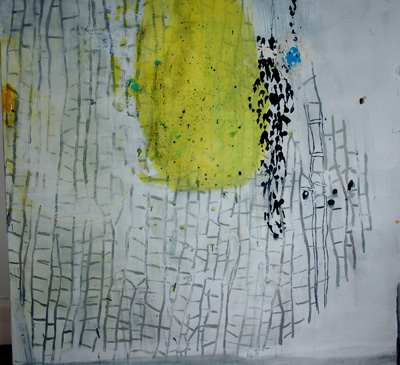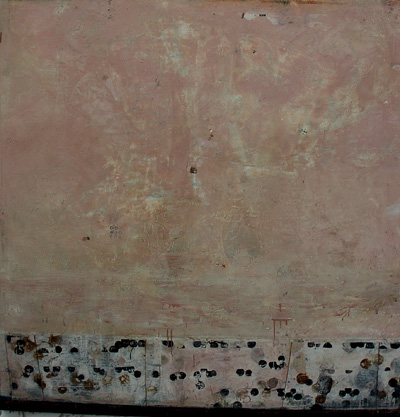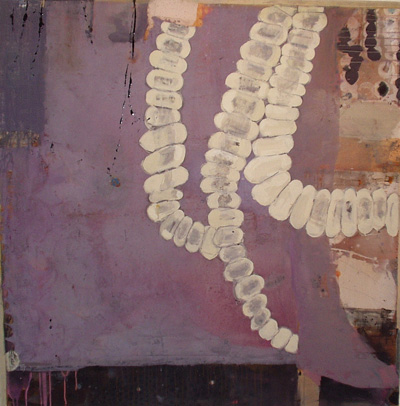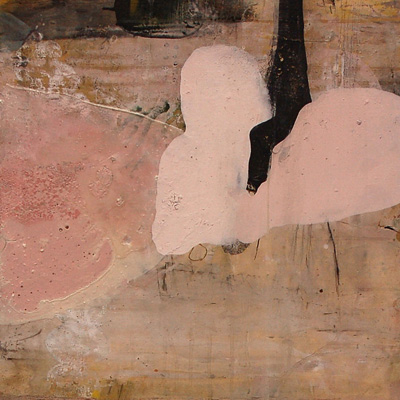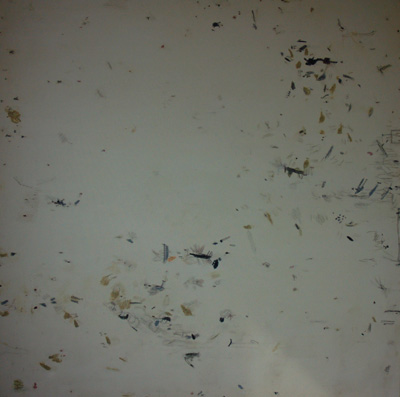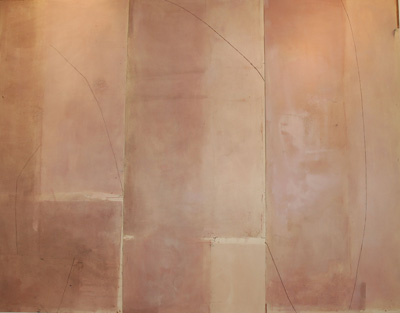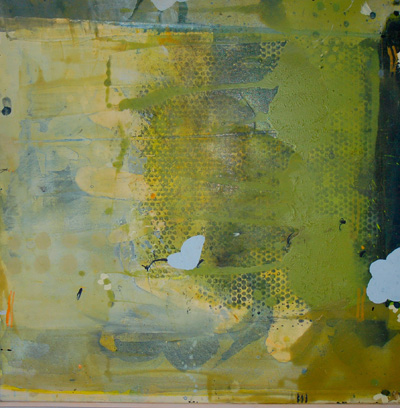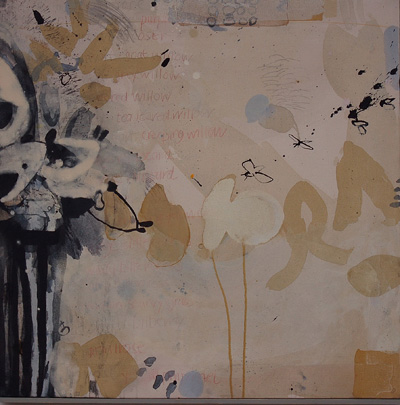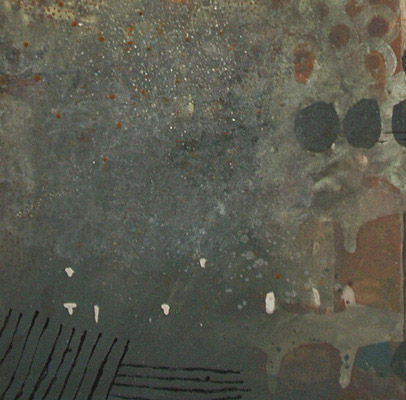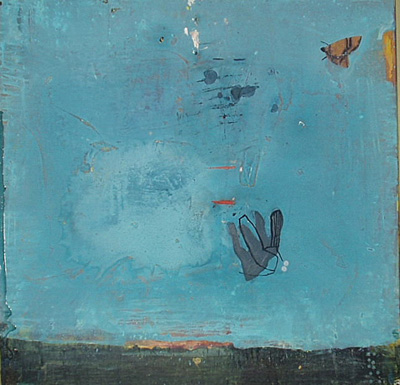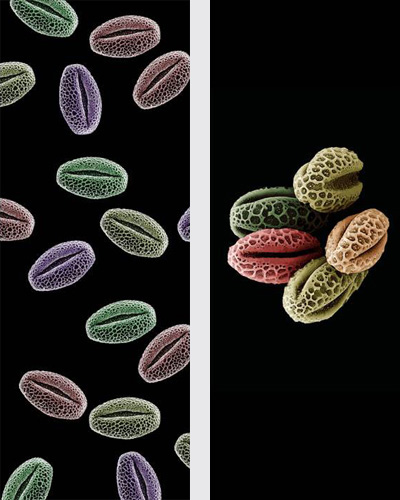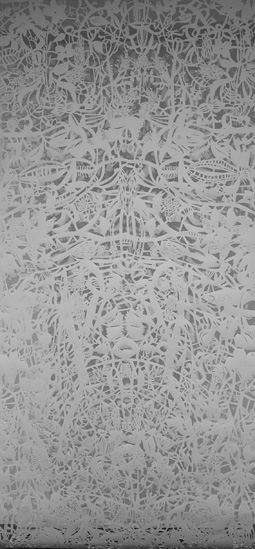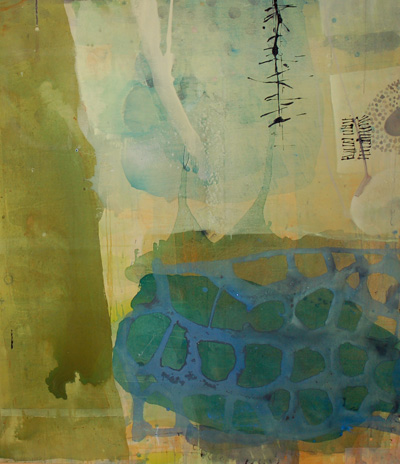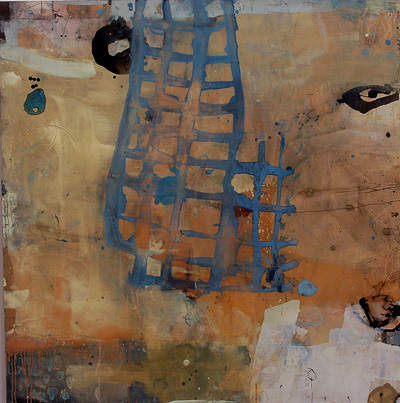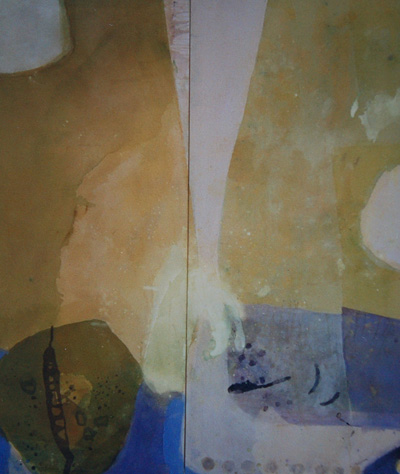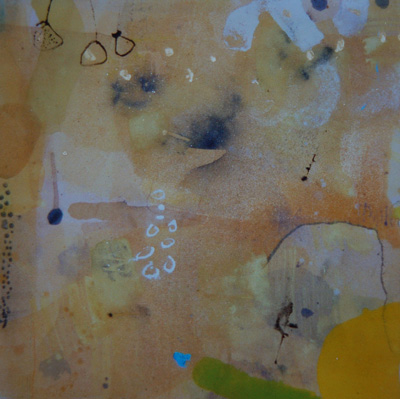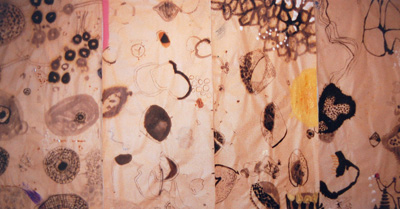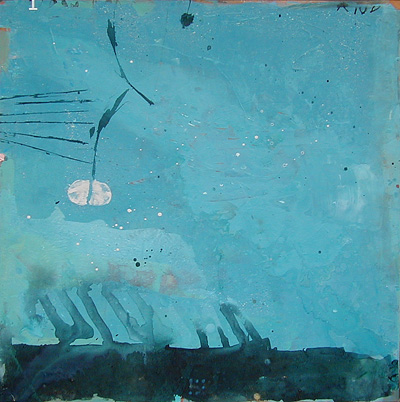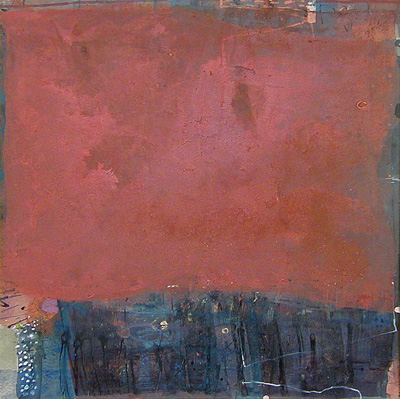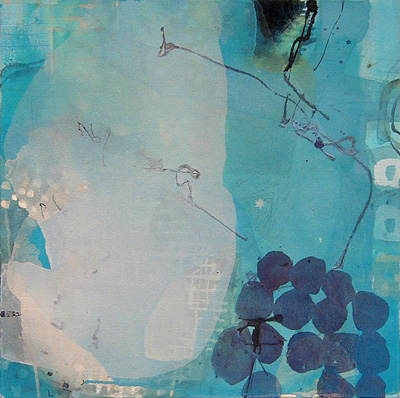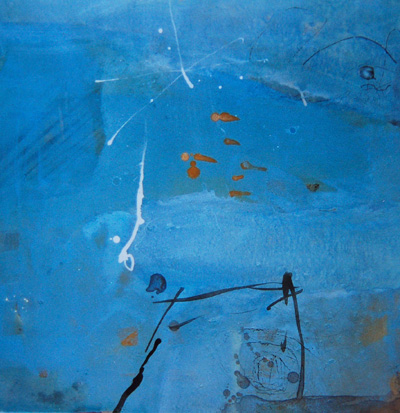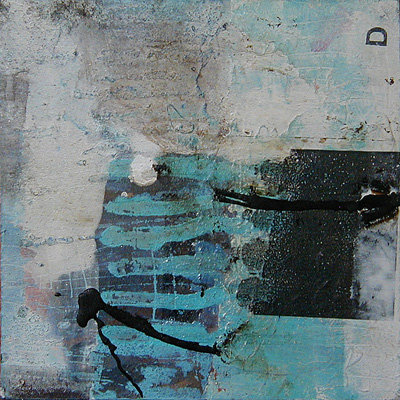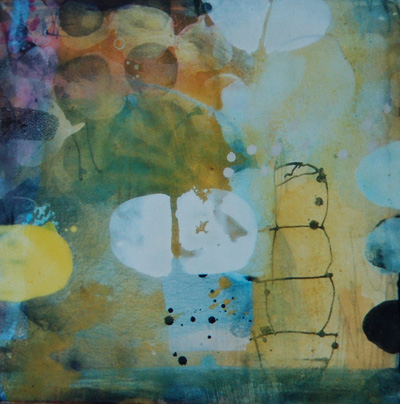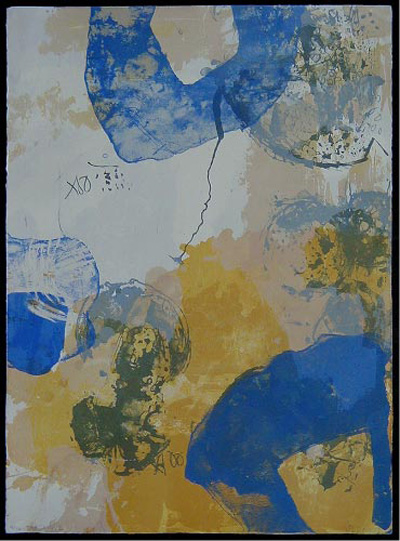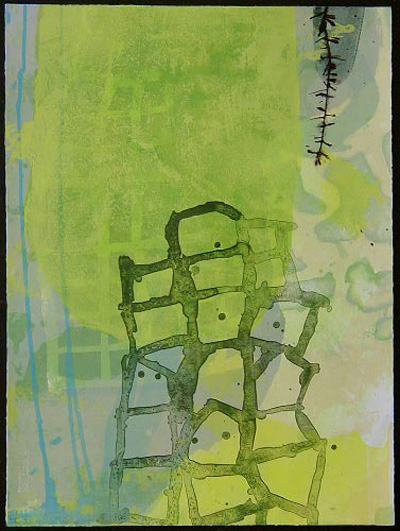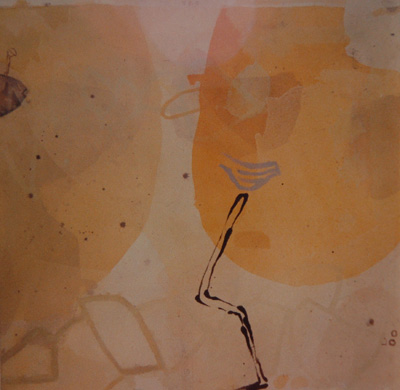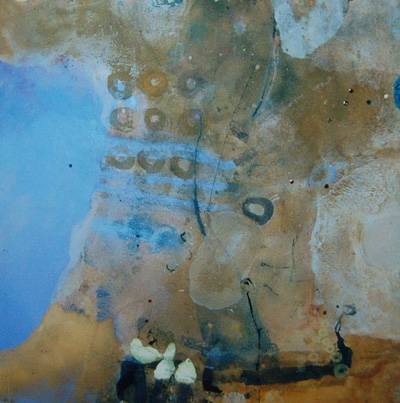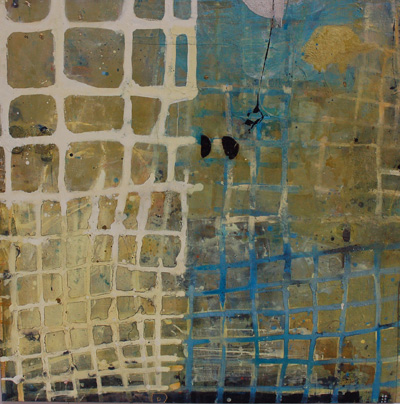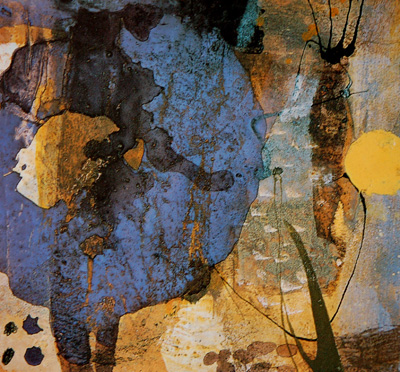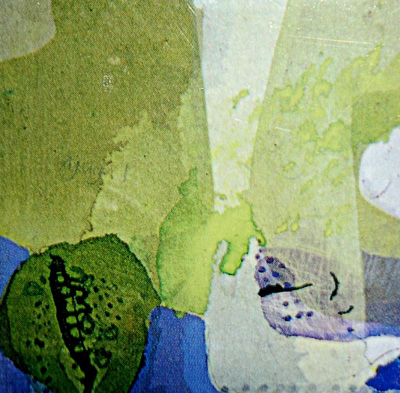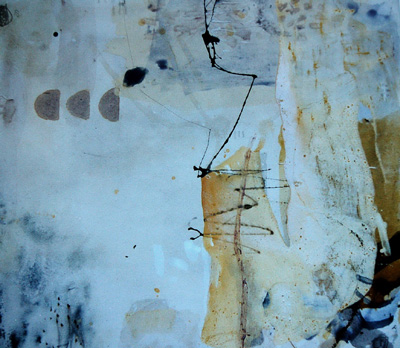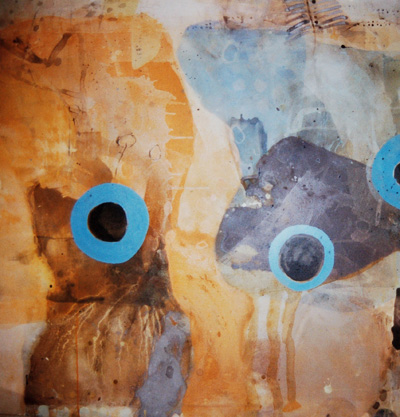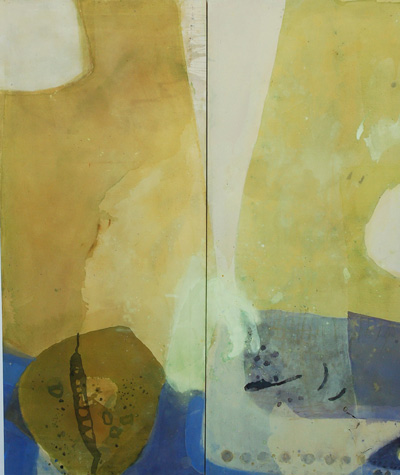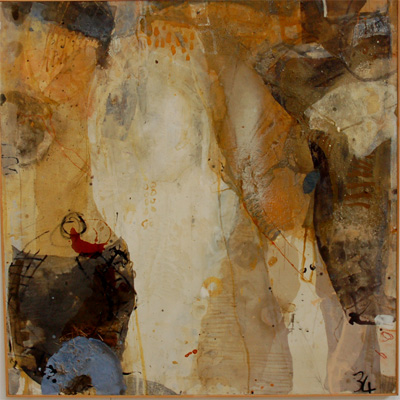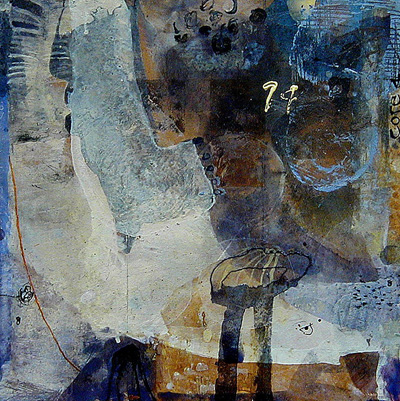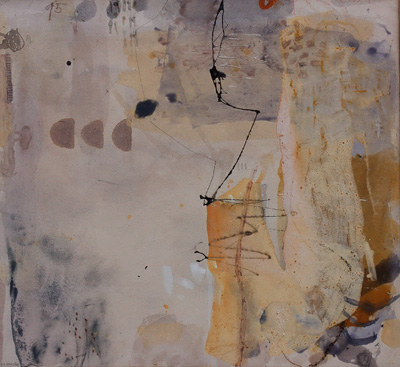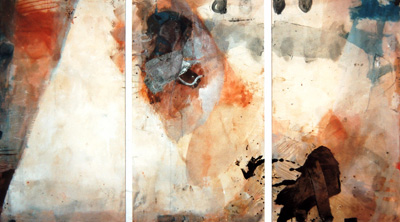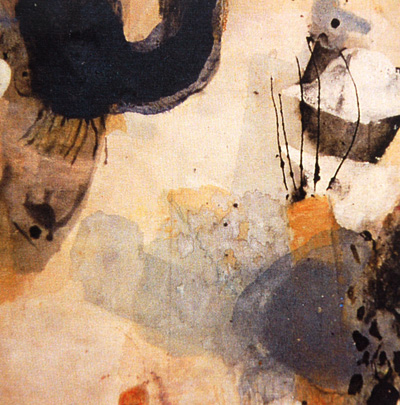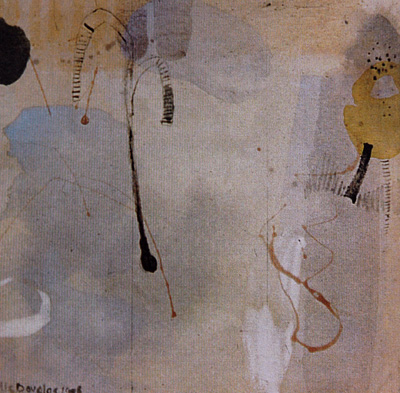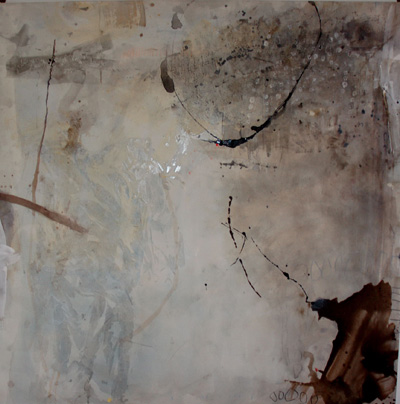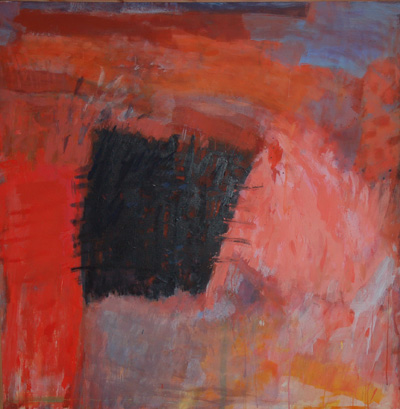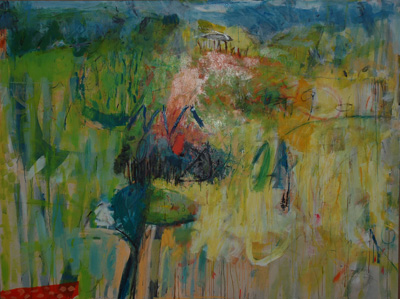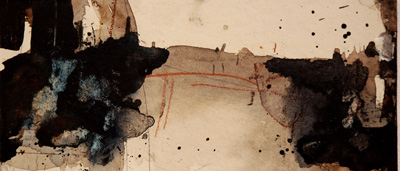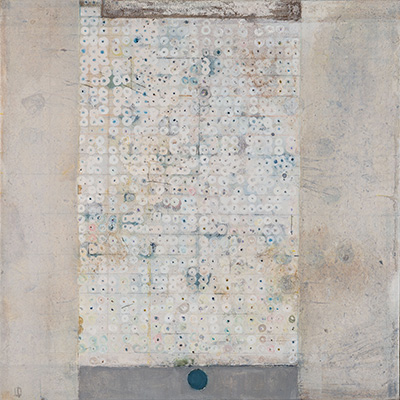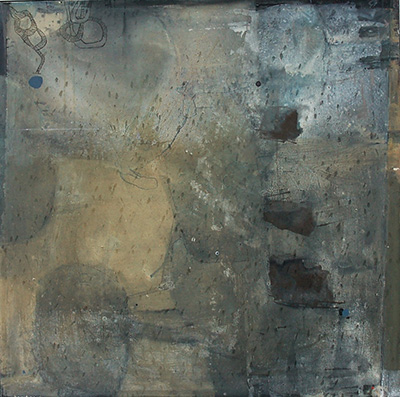Gallery of Work¶
Flow¶
Flow Series - Liz said:
These new works develop visual ideas from research made into specific environments in the North. Over the last 5 years I have made journeys to The Flow Country; Iceland and Orkney.
These paintings are meditations from these journeys. I am fascinated by the sea which is treacherous and also beautiful and quiet dark inland pools. The inner and outer edges of land and sea are of particular interest.
Tools for Survival¶
‘Tools for Survival’ – a conversation between artists Liz Douglas, Jenny Pope and Felicity Bristow.
The aim of this new work by Liz Douglas is “Transformation” and what it takes to transform our humble objects into works of art using a variety of materials and methods.
Liz said
The object of particular interest to me is an 18th century shepherd’s lantern from the Live Borders Selkirk Museum Archive. ‘The Shepherd’s Calendar’ by James Hogg (Edinburgh University Press, 2002) contains historical narratives about shepherds’ in the 17th and 18th century who endured violent snow-storms.
The metaphor of the lantern is one of survival, light and dark, illumination and vision. These metaphors are from a rural environment but equally relevant to an urban environment.
In my investigations into materiality I considered- Can we still read the weather? Are these observational skills still needed and used? Do we rely too much on the ‘experts’ and the weather apps to tell us what the weather is and is going to be? Are we in danger of losing the ability to observe and make independent decisions which impact on our survival?
Storms
‘The Thirteen Drifty Days’ and ‘The Blast o’ March’
These works are inspired by two stories from Storms - ‘The Thirteen Drifty Days’ and ‘The Blast o’March’ from James Hogg's ‘The Shepherd’s Calendar’
The stories are about two devastating storms which occurred in the South of Scotland in the 17th century and remain in the memory of people for their severity. This is one story….
The Blast o’ March
Which happened on the 24th day of that month in the year 16… on a Monday’s morning; and though it lasted only for one forenoon, it was calculated to have destroyed upwards of a thousand scores of sheep, as well as a number of shepherds. There is one anecdote of this storm that is worthy of being preserved as it is shows with how much attention shepherds as well as sailors should observe the appearances of the sky. The Sunday evening before was so warm that the lasses went home from church barefoot, and the young men threw off their plaids and coats and carried them over their shoulders. A large group of these younkers going home from the church of Yarrow equipped in this manner chanced to pass by an old shepherd on the farm of Newhouse named Walter Blake who had all his sheep gathered into the side of a wood. They asked at Watie, who was a very religious man what could have induced him to gather his sheep on the Sabbath day? He answered that he had seen an ill-hued weather-gaw that morning and was afraid it was going to be a drift. There were so much amused at Watie’s apprehensions that they clapped their hands and laughed at him and one pert girl cried.
“Aye fie tak’ care Watie; I wadna say but it may be thrapple deep or the morn.” Another asked if he wasna rather feared for the sun burning the een out o’ their heads? and a third if he didna keep a correspondence wi’ the thieves an’ kend they were to ride that night. Watie was obliged to bear all this for the evening was fine beyond anything generally seen at that season and only said to them at parting “Weel weel callans; time will try a; let him laugh that wins; but slacks will be sleek, a hogg for the howking; we’ll a’ get horns to tout on the morn.” The saying grew proverbial but Watie was the only man who saved the whole of his stock in that country.”
James Hogg, The Shepherds Calendar, Edinburgh University Press, 2002, p2-3
Liz Douglas acknowledges support towards this project from a Visual Artist and Craft Maker Award: South of Scotland 2019 in partnership with Creative Scotland.
Pools and Pockets¶
Pools and Pockets
This series further explores the research material from 'Whitlaw Mosses' in the Scottish Borders and 'Intranquility' from a Scottish Society of Artists curated project investigating plants around Ullapool in the North West Highlands.
Intranquility¶
This was a curated group exhibition organised by SSA members Katharine Aarestaad and David C Forster, exhibited at An Talla Solais, Ullapool June 25 to 16 August 2016.
Liz said
The exhibition title is a subversive play on the word tranquillity, which is so often used to describe beautiful and remote locations such as Ullapool, using the theme as a starting point to explore less traditional approaches to landscape, land, place and the environment in contemporary art.
These two new paper works are a dialogue between the hand-made and the machine-made exploring visible and invisible aspects of my subject matter in order to challenge my own perceptions of landscape. The idea of ‘land at the edge of the sea’ is a visual metaphor that interests me.
The subject matter that I have researched is three plants first recorded in the Ullapool area in the 1700s which I used to find a way of linking the past with the present and an imagined future.
These plants are found in limestone soil on the edge of the ‘Moine Thrust’. They are plants that were growing there before major changes in land use – fishing, forestry, sporting estates and sheep farming and still exist today. I am also interested in the programmes of a vision to connect habitats in the area just north of Ullapool as part of regeneration projects.
The plants are:
- Gall-uninnseann ma creole – Rock whitebeam – Sorbus rupicola
- Raineach-chuilinn – Holly fern – Polystichum lonchitis
- Lady’s mantle – Alchemilla glaucescens
Empire: Flax - Lines of Enquiry¶
A Society of Scottish Artists members’ exhibition curated by Gayle Nelson PSSA & Alan Bond SSA
Pliny the elder
“Thus to sow a thing in the ground for the purposes of catching the winds and tempests; it being not enough ….., forsooth, to be borne upon the waves alone!”
Liz Douglas - July 2015
This piece of artwork researches the flax plant, (Linum usitatissimum)- lint in old Scots, which is an ancient plant cultivated all over the world from earliest times. It was also cultivated in Scotland and used as the source material in the making of coarse linen, used in sail making in the shipping trade to and from the port of Montrose.
The emphasis that I have given to this work is that of a ‘work-in-progress’, where the paper itself is the working surface on which marks and lines are drawn, printed, etched and laser-cut. The paper is a place where the act of making the work is akin to a voyage, where the unpredictable occurs, referencing my researches into flax and trade with the Empire. This work is a result of extensively sifting material gathered, to explore the boundaries between the handmade and machine made, to convey something about Empire with an emphasis on the poetic.
The research element of this project has been funded by Visual Artist and Craft Maker Awards: South of Scotland 2014-15 in partnership with Creative Scotland.
I wish to thank the staff at Angus Council; Dundee City Archives; Montrose Museum; Arbroath Signal Tower Museum; Restenneth Priory, Forfar; John Aitken, and The Royal Botanic Gardens, Edinburgh, for their help and support during the research stage of this project.
Creative Place 2014 Commission¶
Creative Place 2014 Commission - Liz said:
This new work is from a commission by Peebles Creative Place 2014 for the Eastgate Theatre and Arts Centre, Peebles to create drawings using imagery from the north atlantic salmon using natural light effects to incorporate the piece into the landscape.
In the panels I have tried to convey something of the mystery and occasional visibility of the salmon on its journey from Greenland to the River Tweed.
This work is an exploration of the boundaries between the handmade and the machine made using the lasercutter as an innovative drawing tool. This has been an opportunity to use opal cast acrylic as the medium for the two drawings.
The two acrylic drawings, Peel 1 and 2, are named after a reference in the Border Ballads where a peel is a pool.
'Con-TEXT Residency 2012' - Heriot Watt University, Galashiels¶
About 'Con-TEXT Residency'
Liz Douglas had been using lasercutting as an innovative drawing tool, using scanning electron microscopic images – the ‘invisible structures’ of diatoms from Whitlaw Mosses research project.
Liz was one of six artists and designers from the Scottish Borders and Dumfries and Galloway to have the opportunity to expand her ideas, explore technology and develop innovative work through a residency at Heriot Watt University School of Textiles and Design.
The initiative was funded through Creative Scotland’s ‘Creative Futures’ programme and coordinated by the Creative Arts Business Network.
'Out of the Mire' - Visual Artist Award 2011¶
'Out of the Mire' - Liz said:
A Creative Scotland/ CABN/ Visual Artists Award enabled me time to experiment with the lasercutting process, in relation to painting and print at Heriot Watt University, Galashiels.
I used research material from the Whitlaw Mosses, in the Scottish Borders – a site of special scientific interest, managed by Scottish Natural Heritage.
This project followed on from initial workshop on the lasercutting process with artist Jenny Smith at The Edinburgh Laser Cutting Studio, Wasps Artists Studios, Patriothall, Edinburgh.
'Way' - a painted ceiling¶
Liz made her first ceiling painting for a bothy near Ettrick Pen on the Southern Upland Way, as part of the ‘Way’ Project.
Parnassia Palustris - Grass of Parnassus
Walt Whitman - Leaves of Grass 1891
I believe a leaf of grass is no less
Than a journey-work of the stars
A way of mind in mythology – Mount Parnassus, and the Greek muses of poetry and song, of astronomy and meditation, of both art and science.
A way of making: fine lines of the plant stem and root, colours of rock and place, shapes of microscopic pollen grain. All echo the plant – this ‘honorary grass’.
We sense place in our journeys by foot or by road to get to this ‘bay in the hills’ which is Over Phawhope.
Carl Linnaeus (1707-1778).
A painted ceiling as a poetic mediation on the flower Grass of Parnassus, once known as ‘bog star’, later named by Swedish biologist and taxonomist
The Way project, an installation by 5 artists / writers – Liz Douglas, Kate Foster, Allan Harkness, Andrew Mackenzie, Mary Morrison.
Mire Series¶
Liz had been researching diatoms at Whitlaw Mosses National Nature Reserve, near Selkirk, for three years as part of a collaborative art/science funded project.
Inspiration
Diatoms are microscopic algae found in the ancient pools at Whitlaw Mosses. Liz said: "The beauty and diversity of the diatoms found in the pools at Whitlaw Mosses are amazing. It is like the deep ocean in miniature."
The reserve, managed by Scottish Natural Heritage, is a basin fen lying in a landscape shaped in corrugations from the last ice age,with damp fens, fed by ground water, set in hollows. The peat is nine metres deep in places and although some of the peat and marl were dug from parts of the mosses the turfs were put back afterwards which kept the seed bank intact and enabled plants to return. The reserve also contains nationally rare water beetles and nationally scarce plants, mosses and liverworts.
The painting and drawing in ‘Mire’ exhibition are the beginnings of a visual exploration of her research work around the site pools using contemporary practices in the making of new work.
Ideas for the paintings in ‘Mire’ explore: - a place as a ‘raft’ of vegetation; - a place of deep pools of water; - a place of edges and boundaries.
The project was grant-aided by Scottish Natural Heritage, assisted by RBGE, SEPA and SBC.
Seeds of Time 2 Series¶
This work is inspired by research at Ettrick Marshes. The project was a part collaboration with Frieda Christie, The Royal Botanic Gardens, Edinburgh and Dr Jon Mercer, Scottish Borders Biological Records, Harestanes.
The quiet richness of the Ettrick Marshes is the inspiration behind this collaborative project. “I try to assimilate the many layers of information, both scientific and sensory associated with a natural site, to produce something which is calm, subtle and surprising.” Liz Douglas
Elizabeth Hume, Visual Arts Officer, Scottish Borders Council.
One of the most striking aspects of Liz’s work is the way she delicately layers beautiful colours on top of each other and makes you marvel at a world unseen by the naked eye.
Willowlines Series¶
This body of work is inspired by the willow species at the Ettrick Marshes and is part of a collaborative project.
Liz worked with Frieda Christie, The Royal Botanic Gardens, Edinburgh, and Dr Jon Mercer from The Scottish Borders Biological Records Centre, Harestanes.
A disc of the process was made to accompany the exhibition.
Interface Series¶
About 'Interface Series' Liz said:
I was selected to take part in a project initiated by the Scottish Touring Exhibitions Consortium. All nine artists involved evidence a strong interest or link to scientific origin/inspiration in their work and currently undertaking collaborations in scientific research or have plans to do so in the near future.
My work focuses on natural forms from particular areas of ground and the activities present and past which leave trace marks. Regeneration interests me as does the unseen element in the landscape. Science is also a valuable part of the process. I look at pollen grains of seeds through a scanning electron microscope to reveal structural elements.
Textured and stained canvasses scraped at and poured onto give a feeling of layers of time, infinite variation, and movement, as well as structure and form revealing another dimension to the natural world – that of the unexpected and unpredictable.
Exhibited venues 2001-2004:
- Crawford Arts Centre, St Andrews
- Dick Institute, Kilmarnock
- St Fergus Gallery, Wick
- Swanson Gallery, Thurso
- Gracefield Arts Centre, Dumfries
- Old Gala House, Galashiels
RB Series¶
About 'RB Series' Liz said:
This series is about the Rotten Bottom Bog – a raised bog situated above the Carrifran valley in the Moffatdale Valley.
The paintings concern a sense of time and place in the vastness of this particular landscape.
It is the place where a bow was found and thought to be 6000 years old. I was influenced by the visual nature of the core pollen samples taken from the Rotten Bottom Bog during a research project by University of Stirling to ascertain what trees existed in this valley over 6000 years ago and the landscape above the Carrifran Valley.
Carrifran Series¶
About Carrifran
Carrifran is a bow shaped valley in the Moffat hills in border country.
This valley is the site of a regeneration of the habitat which perhaps once existed over 6000 years ago. Much of the planting has been done over the past 10 years or more from seeds collected from species found as near to the site as possible. Pollen samples were taken from Rotten Bottom Bog to identify what trees grew there in the past.
Much of the work was inspired by the wildness of the place and the idea of imagining an environment which once existed and the determination of the people to create or recreate something for future generations.
Hanging Gardens Series¶
This series is about a place called the Hanging Gardens, above Loch Skene in the Border hills. The site nestles between two rock faces with a river flowing through it. On the rocks are the remains of alpine plants brought there after the ice age. The walking to the site was as much a part of the inspiration for this work as the site itself.
Dob's Lynn Series¶
Dob’s Lynn is a fascinating ancient site where graptolites- tiny glittery fossils- are found in the rock formations. It is on a fault line and 2000’ above sea level in the Border hills with a small stream running through it. This land, 450 million years ago, was situated south of the equator. The temperature of the water where the graptolites lived at that time was probably around 25°C. This land has been moving northwards over a long period of time. This is the inspiration for this series of work.
Yarrow Series¶
This work is about areas of ground in the Yarrow Valley around a specific narrative which informs each one.
Ettrick Series¶
This work is an ongoing visual dialogue with the Ettrick Valley. These paintings use elements from specific landscapes at the macro and micro level
